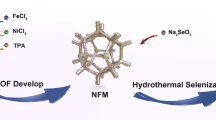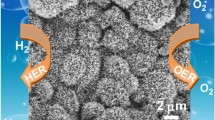Abstract
Nickel-based selenides have attracted widespread attention as promising electrocatalysts for water splitting. This work proposes a novel and facile method to fabricate an efficient electrocatalyst based on morphological controlled nickel diselenide nanoparticles using L-cysteine (NiSe2-L) via atmospheric pressure hydrothermal. The NiSe2-L was prepared inside a round-bottom flask under stirring conditions in an oil bath at 100 ℃ for 4 h. This method no longer required posttreatment, just used L-cysteine for morphological control, and the reaction time was shortened to only 4 h. As expected, the NiSe2-L electrode exhibited good catalytic performance towards oxygen evolution reaction (OER) with an overpotential of 398 mV at the current density of 100 mA cm−2 and maintained a Faraday efficiency of up to 99% in 1 M KOH. Moreover, this electrode showed long-term stability with small overpotential increases (~ 16 mV) at 100 mA cm−2 after 5000 cycles of CV scans. Therefore, this work provided a facile synthesis method of nickel-based selenides with potential use value for OER in alkaline solutions.








Similar content being viewed by others
References
Esmailzadeh S, Shahrabi T, BaratiDarband G, Yaghoubinezhad Y (2020) Pulse electrodeposition of nickel selenide nanostructure as a binder-free and high-efficient catalyst for both electrocatalytic hydrogen and oxygen evolution reactions in alkaline solution. Electrochimica Acta 334:135549. https://doi.org/10.1016/j.electacta.2019.135549
Wang G, Chen W, Chen G, Huang J, Song C, Chen D, Du Y, Li C, Ostrikov KK (2020) Trimetallic Mo–Ni–Co selenides nanorod electrocatalysts for highly-efficient and ultra-stable hydrogen evolution. Nano Energy 71:104637. https://doi.org/10.1016/j.nanoen.2020.104637
Yang H, Huang Y, Teoh WY, Jiang L, Chen W, Zhang L, Yan J (2020) Molybdenum selenide nanosheets surrounding nickel selenides sub-microislands on nickel foam as high-performance bifunctional electrocatalysts for water splitting. Electrochim Acta 349:136336. https://doi.org/10.1016/j.electacta.2020.136336
Song J, Wei C, Huang Z-F, Liu C, Zeng L, Wang X, Xu ZJ (2020) A review on fundamentals for designing oxygen evolution electrocatalysts. Chem Soc Rev 49(7):2196–2214. https://doi.org/10.1039/C9CS00607A
Zhang L, Wang Q, Li L, Banis MN, Li J, Adair K, Sun Y, Li R, Zhao Z-J, Gu M, Sun X (2022) Single atom surface engineering: a new strategy to boost electrochemical activities of Pt catalysts. Nano Energy 93:106813. https://doi.org/10.1016/j.nanoen.2021.106813
Lin C, Li J-L, Li X, Yang S, Luo W, Zhang Y, Kim S-H, Kim D-H, Shinde SS, Li Y-F, Liu Z-P, Jiang Z, Lee J-H (2021) In-situ reconstructed Ru atom array on α-MnO2 with enhanced performance for acidic water oxidation. Nat Catal 4(12):1012–1023. https://doi.org/10.1038/s41929-021-00703-0
Zheng Y-R, Vernieres J, Wang Z, Zhang K, Hochfilzer D, Krempl K, Liao T-W, Presel F, Altantzis T, Fatermans J, Scott SB, Secher NM, Moon C, Liu P, Bals S, Van Aert S, Cao A, Anand M, Nørskov JK, Kibsgaard J, Chorkendorff I (2022) Monitoring oxygen production on mass-selected iridium–tantalum oxide electrocatalysts. Nat Energy 7(1):55–64. https://doi.org/10.1038/s41560-021-00948-w
Huang Z, Yuan S, Zhang T, Cai B, Xu B, Lu X, Fan L, Dai F, Sun D (2020) Selective selenization of mixed-linker Ni-MOFs: NiSe2@NC core-shell nano-octahedrons with tunable interfacial electronic structure for hydrogen evolution reaction. Appl Catal B 272:118976. https://doi.org/10.1016/j.apcatb.2020.118976
Ede SR, Luo Z (2021) Tuning the intrinsic catalytic activities of oxygen-evolution catalysts by doping: a comprehensive review. J Mater Chem A 9(36):20131–20163. https://doi.org/10.1039/D1TA04032D
Gao L, Cui X, Sewell CD, Li J, Lin Z (2021) Recent advances in activating surface reconstruction for the high-efficiency oxygen evolution reaction. Chem Soc Rev 50(15):8428–8469. https://doi.org/10.1039/D0CS00962
Huang Y, Jiang L-W, Shi B-Y, Ryan KM, Wang J-J (2021) Highly efficient oxygen evolution reaction enabled by phosphorus doping of the Fe electronic structure in iron–nickel selenide nanosheets. Adv Sci 8(18):2101775. https://doi.org/10.1002/advs.202101775
Han MH, Pin MW, Koh JH, Park JH, Kim J, Min BK, Lee WH, Oh H-S (2021) Improving the oxygen evolution reaction using electronic structure modulation of sulfur-retaining nickel-based electrocatalysts. J Mater Chem A 9(47):27034–27040. https://doi.org/10.1039/D1TA07591H
Yi X, He X, Yin F, Chen B, Li G, Yin H (2020) Amorphous Ni–Fe–Se hollow nanospheres electrodeposited on nickel foam as a highly active and bifunctional catalyst for alkaline water splitting. Dalton Trans 49(20):6764–6775. https://doi.org/10.1039/C9DT04755G
Feng Y, Wang S, Wang H, Zhong Y, Hu Y (2020) An efficient and stable Ni–Fe selenides/nitrogen-doped carbon nanotubes in situ-derived electrocatalyst for oxygen evolution reaction. J Mater Sci 55(28):13927–13937. https://doi.org/10.1007/s10853-020-05002-w
Saxena A, Liyanage WPR, Kapila S, Nath M (2022) Nickel selenide as an efficient electrocatalyst for selective reduction of carbon dioxide to carbon-rich products. Catal Sci Technol 12(15):4727–4739. https://doi.org/10.1039/d2cy00583b
Xiong P, Ao X, Chen J, Li J-G, Lv L, Li Z, Zondode M, Xue X, Lan Y, Wang C (2019) Nickel diselenide nanoflakes give superior urea electrocatalytic conversion. Electrochim Acta 297:833–841. https://doi.org/10.1016/j.electacta.2018.12.043
Zhang F, Pei Y, Ge Y, Chu H, Craig S, Dong P, Cao J, Ajayan PM, Ye M, Shen J (2018) Controlled synthesis of eutectic NiSe/Ni3Se2 self-supported on Ni foam: an excellent bifunctional electrocatalyst for overall water splitting. Adv Mater Interfaces 5(8):1701507. https://doi.org/10.1002/admi.201701507
Ramakrishnan P, Jo S, Pitipuech N, Sohn JI (2020) Bifunctionality behavior of phase controlled nickel selenides in alkaline water electrolysis application. Electrochim Acta 354:136742. https://doi.org/10.1016/j.electacta.2020.136742
Chang J, Wang G, Yang Z, Li B, Wang Q, Kuliiev R, Orlovskaya N, Gu M, Du Y, Wang G, Yang Y (2021) Dual-doping and synergism toward high-performance seawater electrolysis. Adv Mater 33(33):2101425. https://doi.org/10.1002/adma.202101425
Esmailzadeh S, Shahrabi T, Yaghoubinezhad Y, BaratiDarband G (2021) Optimization of nickel selenide for hydrogen and oxygen evolution reactions by response surface methodology. J Colloid Interface Sci 600:324–337. https://doi.org/10.1016/j.jcis.2021.05.003
Tan L, Yu J, Wang H, Gao H, Liu X, Wang L, She X, Zhan T (2022) Controllable synthesis and phase-dependent catalytic performance of dual-phase nickel selenides on Ni foam for overall water splitting. Appl Catal B 303:120915. https://doi.org/10.1016/j.apcatb.2021.120915
Sobhani A, Salavati-Niasari M (2021) Transition metal selenides and diselenides: hydrothermal fabrication, investigation of morphology, particle size and and their applications in photocatalyst. Adv Coll Interface Sci 287:102321. https://doi.org/10.1016/j.cis.2020.102321
Sharifi E, Shams E, Salimi A, Noorbakhsh A, Amini MK (2018) Nickel-cysteine nanoparticles: synthesis, characterization and application for direct electron transfer studies. Colloids Surf, B 165:135–143. https://doi.org/10.1016/j.colsurfb.2018.01.052
Di Y, Ma C, Fu Y, Dong X, Liu X, Ma H (2021) Engineering cationic sulfur-doped Co3O4 architectures with exposing high-reactive (112) facets for photoelectrocatalytic water purification. ACS Appl Mater Interfaces 13(7):8405–8416. https://doi.org/10.1021/acsami.0c20353
Siddiqui S, Niazi JH, Qureshi A (2021) Mn3O4–Au nanozymes as peroxidase mimic and the surface-enhanced Raman scattering nanosensor for the detection of hydrogen peroxide. Mater Today Chem 22:100560. https://doi.org/10.1016/j.mtchem.2021.100560
Oluwafemi SO, Revaprasadu N, Ramirez AJ (2008) A novel one-pot route for the synthesis of water-soluble cadmium selenide nanoparticles. J Cryst Growth 310(13):3230–3234. https://doi.org/10.1016/j.jcrysgro.2008.03.032
Burford N, Eelman MD, Mahony DE, Morash M (2003) Definitive identification of cysteine and glutathione complexes of bismuth by mass spectrometry: assessing the biochemical fate of bismuth pharmaceutical agents. Chem Commun (1):146–147. https://doi.org/10.1039/B210570E
Xiong S, Xi B, Wang C, Zou G, Fei L, Wang W, Qian Y (2007) Shape-controlled synthesis of assistance synthesis of 3D and 1D structures of CdS in a binary solution with L-cysteine’s. Chem A Euro J 13:3076–3081. https://doi.org/10.1002/chem.200600786.
Zuo F, Yan S, Zhang B, Zhao Y, Xie Y (2008) L-cysteine-assisted synthesis of PbS nanocube-based pagoda-like hierarchical architectures. J Phys Chem C 112(8):2831–2835. https://doi.org/10.1021/jp0766149
Jeghan SMN, Lee G (2020) One-dimensional hierarchical nanostructures of NiCo2O4, NiCo2S4 and NiCo2Se4 with superior electrocatalytic activities toward efficient oxygen evolution reaction. Nanotechnology 31(29):295405. https://doi.org/10.1088/1361-6528/ab8667
Peng H, Wei C, Wang K, Meng T, Ma G, Lei Z, Gong X (2017) Ni0.85Se@MoSe2 nanosheet arrays as the electrode for high-performance supercapacitors. ACS Appl Mater Interfaces 9(20):17067–17075. https://doi.org/10.1021/acsami.7b02776.
Qu G, Zhang X, Xiang G, Wei Y, Yin J, Wang Z, Zhang X, Xu X (2020) ZIF-67 derived hollow Ni-Co-Se nano-polyhedrons for flexible hybrid supercapacitors with remarkable electrochemical performances. Chin Chem Lett 31(7):2007–2012. https://doi.org/10.1016/j.cclet.2020.01.040
van der Heide H, Hemmel R, van Bruggen CF, Haas C (1980) X-ray photoelectron spectra of 3d transition metal pyrites. J Solid State Chem 33(1):17–25. https://doi.org/10.1016/0022-4596(80)90543-5
Lian KK, Kirk DW, Thorpe SJ (1995) Investigation of a “two-state” Tafel phenomenon for the oxygen evolution reaction on an amorphous Ni-Co alloy. J Electrochem Soc 142(11):3704–3712. https://doi.org/10.1149/1.2048402
Mansour AN, Melendres CA (1994) Characterization of electrochemically prepared γ-NiOOH by XPS. Surf Sci Spectra 3(3):271–278. https://doi.org/10.1116/1.1247756
Chen Y, Ren Z, Fu H, Zhang X, Tian G, Fu H (2018) NiSe-Ni0.85 Se heterostructure nanoflake arrays on carbon paper as efficient electrocatalysts for overall water splitting. Small 14(25):1800763
Faber MS, Jin S (2014) Earth-abundant inorganic electrocatalysts and their nanostructures for energy conversion applications. Energy Environ Sci 7(11):3519–3542. https://doi.org/10.1039/C4EE01760A
Funding
The authors received financial support provided by National Natural Science Foundation of China (NO. 21673167), the open project of Hubei Key Laboratory of New Textile Materials and Applications (No. FZXCL202110), and the start-up fund of Wuhan Textile University (NO. 20200630 and 20200828).
Author information
Authors and Affiliations
Corresponding authors
Ethics declarations
Competing interests
The authors declare no competing interests.
Additional information
Publisher's note
Springer Nature remains neutral with regard to jurisdictional claims in published maps and institutional affiliations.
Supplementary information
Below is the link to the electronic supplementary material.
Rights and permissions
Springer Nature or its licensor (e.g. a society or other partner) holds exclusive rights to this article under a publishing agreement with the author(s) or other rightsholder(s); author self-archiving of the accepted manuscript version of this article is solely governed by the terms of such publishing agreement and applicable law.
About this article
Cite this article
Xu, X., Li, C., Li, N. et al. Facile synthesis of nickel diselenide particles for alkaline oxygen evolution by atmospheric pressure hydrothermal method. Ionics 29, 313–322 (2023). https://doi.org/10.1007/s11581-022-04807-w
Received:
Accepted:
Published:
Issue Date:
DOI: https://doi.org/10.1007/s11581-022-04807-w




